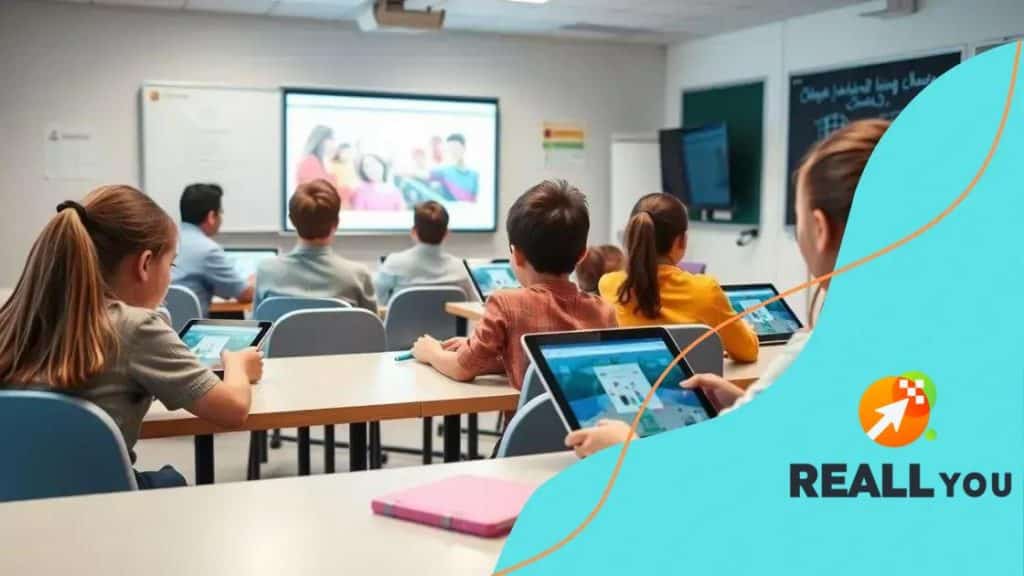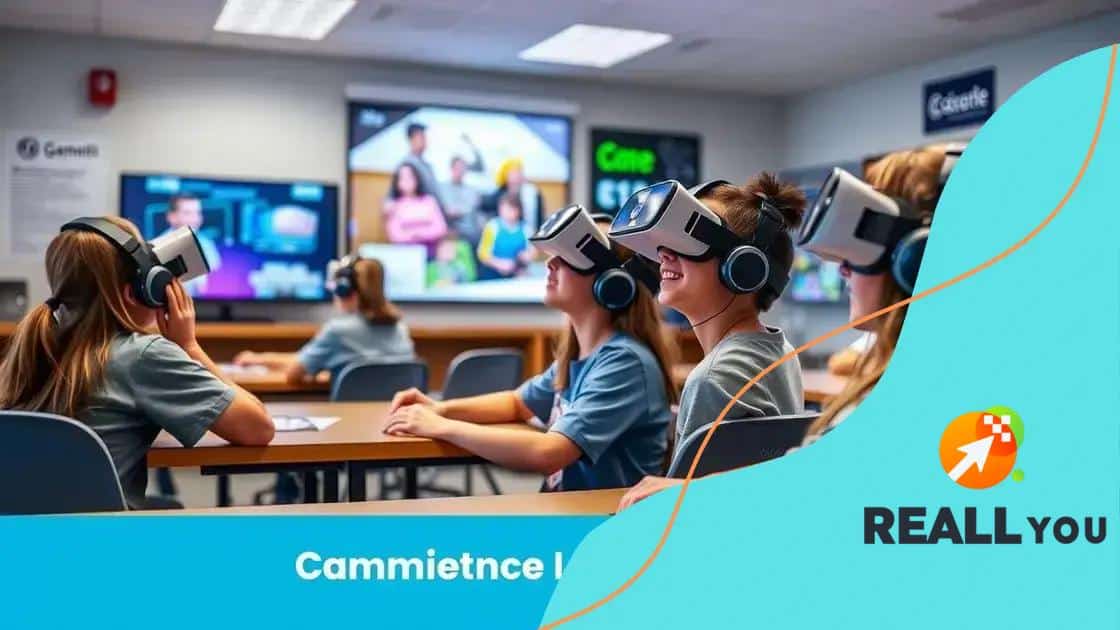The role of EdTech startups in reshaping school systems

Anúncios
The role of EdTech startups in reshaping school systems involves leveraging technology to provide personalized learning experiences, enhance teaching methods, and foster collaboration, ultimately transforming education for both teachers and students.
The role of EdTech startups in reshaping school systems has become increasingly significant in modern education. As technology advances, these startups are introducing creative solutions that enhance learning and engagement. What does this mean for students and educators?
Anúncios
Understanding EdTech startups
Understanding EdTech startups is essential as they play a vital role in the evolution of education. These innovative companies create tech-driven solutions that enhance learning experiences.
Anúncios
One of the main aspects of EdTech startups is their ability to provide personalized learning. This means that students can learn at their own pace, which is especially helpful for those who need extra support or want to advance quickly.
Key Characteristics of EdTech Startups
EdTech startups often share several characteristics that set them apart from traditional educational tools. Here are some key traits:
- Focus on user experience and engagement.
- Integration of advanced technologies like AI and machine learning.
- Flexibility in adapting to various learning styles.
- Collaboration features that connect students and teachers.
Additionally, they leverage data analytics to track student performance. This information helps educators tailor their teaching methods to align with individual needs. For instance, if a student struggles in math, the platform can suggest additional resources to help them improve.
It’s exciting to see how these startups are also reshaping the landscape of education. They often create communities where educators share resources and best practices. This collaboration fosters an environment of continuous improvement.
Challenges Faced by EdTech Startups
Despite their potential, EdTech startups face several challenges. Funding can be a major hurdle, as they need significant resources to develop and market their products.
- Competition with established education companies.
- Regulatory hurdles and compliance with educational standards.
- Ensuring equal access to technology for all students.
Moreover, they must constantly innovate to stay relevant. The fast-paced nature of technology means they need to adapt to changing trends and student needs quickly.
In essence, understanding EdTech startups highlights their contributions and the challenges they encounter. They are not just changing the way we learn; they are paving the way for a more interactive and personalized educational experience.
Key innovations driving change

Key innovations driving change in the EdTech sector are transforming how education is delivered. These innovations not only enhance learning but also make it more accessible and engaging for students.
One of the significant innovations is the use of artificial intelligence. AI can analyze student performance data to provide personalized learning experiences. For instance, AI-driven platforms can adapt content based on how well a student understands the material. This helps students learn at their own pace and enhances their overall educational experience.
Gamification in Learning
Another innovative approach is gamification. By incorporating game-like elements into education, classes can become more engaging. Here are some benefits of gamification:
- Increased motivation among students.
- Enhanced participation in learning activities.
- Promotion of healthy competition.
- Improvement of retention through interactive content.
When students see learning as a game, they are more likely to stay engaged and actively participate. This process makes complex subjects easier to understand and more fun.
Moreover, the integration of virtual reality (VR) and augmented reality (AR) into classrooms is revolutionizing how students experience lessons. With VR, students can take virtual field trips or explore complex environments like the human body in 3D, making learning immersive.
Data-Driven Insights
EdTech startups are also harnessing the power of big data. They collect and analyze vast amounts of data to gain insights into learning patterns. This information allows schools to tailor their programs to meet the needs of their students effectively.
- Identifying areas where students struggle.
- Assessing the effectiveness of teaching methods.
- Helping educators make informed decisions about curriculum.
This data-driven approach not only benefits students but also empowers teachers with the tools they need to enhance their teaching strategies. As technology continues to evolve, these innovations will play a crucial role in shaping the future of education.
Impact on teachers and students
Impact on teachers and students is significant as EdTech startups revolutionize traditional educational methods. These changes create a more interactive and engaging learning environment.
For teachers, one major benefit is the ability to use technology that enhances their teaching. With various platforms, educators can access resources that help create personalized lesson plans. This allows for a better understanding of student needs and preferences.
Benefits for Teachers
Using EdTech tools provides teachers with valuable insights into student performance. Here are some benefits they experience:
- Access to real-time data on student progress.
- Ability to adjust teaching strategies based on analytics.
- Enhanced collaboration with other educators.
- Reduced administrative burden through automation.
When teachers can focus on teaching rather than administrative tasks, they can spend more time facilitating learning and engaging with students.
On the other hand, students also benefit greatly from these innovations. The use of technology in education allows for more interactive learning experiences. Students can collaborate on projects, participate in virtual discussions, and access a wealth of information at their fingertips.
Benefits for Students
EdTech offers several advantages for students, including:
- More personalized learning paths tailored to their unique needs.
- Opportunities for self-directed learning at their own pace.
- Access to diverse resources beyond traditional textbooks.
- Improved engagement through multimedia content.
This transformation fosters a love for learning and encourages students to take ownership of their educational journeys. As a result, their motivation to succeed increases, and they often achieve better academic outcomes.
Overall, the impact of EdTech on teachers and students is profound. By integrating technology into education, both groups reap the benefits of an enhanced learning experience that prepares them for a future surrounded by tech advancements.
Challenges faced by EdTech companies

Challenges faced by EdTech companies are critical to understanding the landscape of educational technology. While these startups offer great potential, they encounter several obstacles that can hinder their growth and effectiveness.
One of the biggest challenges is the issue of funding. Many EdTech startups struggle to secure the necessary investment to develop their products and bring them to market. This can limit their ability to innovate and compete with larger, established companies.
Funding and Investment Issues
Accessing funds is vital for growth, and here are some reasons why EdTech companies face challenges in this area:
- High competition for limited venture capital.
- Lack of awareness among investors about the potential of education technology.
- Longer time frames for profitability compared to other tech sectors.
Moreover, EdTech startups need to continually evolve their offerings to remain relevant in a fast-changing industry.
Another challenge is navigating regulatory policies in the education sector. Compliance with educational standards and regulations can be time-consuming and complex. Companies must stay informed about changes in laws that affect digital learning environments, data privacy, and security.
Regulatory Compliance
Adhering to regulations can be particularly difficult because:
- Regulations vary by region and can change frequently.
- Compliance often requires significant resources and expertise.
- Failure to meet standards can lead to penalties or loss of credibility.
Additionally, EdTech companies must work to ensure that their technology provides equitable access to all students. Disparities in technology access can lead to inequalities in learning outcomes. Addressing these disparities is crucial for creating an inclusive learning environment.
Innovation in educational technology also demands constant adaptation to new tools, which can be overwhelming for startups. Many companies need to keep up with trends like AI, VR, and other emerging technologies while focusing on creating user-friendly platforms.
In summary, while EdTech startups have the potential to transform education, they face significant challenges. These come from funding, regulatory concerns, and ensuring equitable access, all of which require strategic planning and adaptation to succeed in the competitive landscape.
Future trends in educational technology
Future trends in educational technology are shaping how learning is approached in schools and beyond. As technology evolves, it opens new possibilities for enhancing education and making it more accessible.
One major trend is the increased use of artificial intelligence in education. AI can personalize learning experiences by adapting content to suit individual student needs. This means that as students progress, the materials they receive can change to match their learning pace and style.
Personalized Learning Journeys
As personalized learning becomes more common, it’s essential to recognize its key components:
- Custom learning plans that cater to each student’s strengths and weaknesses.
- Real-time feedback mechanisms that inform both students and educators.
- Interactive learning environments that utilize multimedia and gamified elements.
- Integration of adaptive learning technologies that respond to student performance.
Another significant trend is the growth of online and blended learning. This flexible approach allows students to engage with coursework both in-person and through digital platforms, enabling a more tailored educational experience.
Expansion of Online Learning
Online learning platforms are becoming increasingly important. Here are some reasons for this growth:
- Greater access to educational resources for students in remote areas.
- Ability to learn at one’s own pace, accommodating different learning styles.
- Diverse course offerings that meet various interests and career goals.
Moreover, the focus on virtual and augmented reality in education is rising. These technologies create immersive learning experiences that can help students understand complex concepts better.
For instance, VR can enable students to explore historical sites or conduct experiments in a safe virtual environment. This enhances engagement and helps them retain information more effectively.
As educational technology continues to advance, the emphasis on data analytics will also play a crucial role. Schools will increasingly rely on data to make informed decisions about curriculum design and teaching methods.
In summary, the future of educational technology promises exciting changes. With personalized learning experiences, blended learning environments, and immersive technologies, education will become more engaging and effective for learners of all ages.
FAQ – Frequently Asked Questions about EdTech Startups
What are EdTech startups?
EdTech startups are companies that leverage technology to create innovative tools and platforms for enhancing education.
How do EdTech startups benefit teachers?
They provide resources that help personalize lesson plans, making it easier for teachers to address individual student needs.
What impact do EdTech solutions have on student learning?
EdTech solutions offer personalized learning experiences, making education more engaging and accessible for students.
What future trends should we expect in educational technology?
Expect increased use of artificial intelligence, online learning platforms, and immersive technologies like virtual reality in classrooms.






